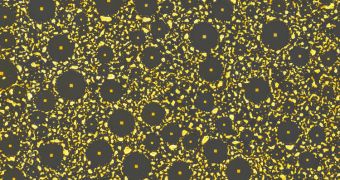A team of experts at the US Department of Energy's (DOE) Lawrence Berkeley National Laboratory (Berkeley Lab) was recently able to provide an accurate explanation for the weird behavior that gold displays at the nanoscale, when heated atop a silicon surface.
The bizarre patterns were first observed by a Berkeley Lab team some 3 years ago. At the time, very tiny layers of gold, measuring just a few nanometers across, were placed on a flat silicon surface, and then heated up. Researchers then allowed the gold to cool on its own.
While this was happening, they were observing the process by using an electron microscope. As they were observing, the gold began to take on very weird patterns, as evidenced in the image to the left.
A large number of circles appeared, as well as a number of irregular blisters between them. At the center of each circle there was a nearly perfect square made up of pure gold. The reason why this arrangement option prevailed has been puzzling scientists ever since.
In a new paper – published in the latest online issue of the esteemed journal Physical Review Letters – researchers propose a new theoretical explanation for this. The key may lie in a class of compounds called eutectic alloys.
These are complex chemicals that result from the combination of two solid materials in the correct proportion. Eutectic alloys melt at temperatures lower than the melting point of either of its components. Gold and silicon can produce such an alloy.
The mixture requires 81 percent gold and 19 percent silicon. The compound is used for connecting various devices in integrated circuits, as well as for processing nanowires and other nanoscale semiconductors. It becomes liquid at 363 degrees Celsius (685.4 degrees Fahrenheit)
One of the most interesting things the team discovered was that the radius of the circle that appeared in the nanoscale gold layer was always the length of the square at its center, raised to the power of 3/2.
“How did the squares get there in the first place? They originated as weak spots that were the sources of the spreading eutectic gold-silicon circles; when the circular eutectic was ruptured the squares filled with the same eutectic, which remained at the centers of the denuded zones,” Berkeley Lab experts say.
“As they cooled, the gold and silicon within the squares separated, leaving sharply defined edges that were pure silicon; the centers were more roughly outlined squares of pure gold,” they conclude.

 14 DAY TRIAL //
14 DAY TRIAL //